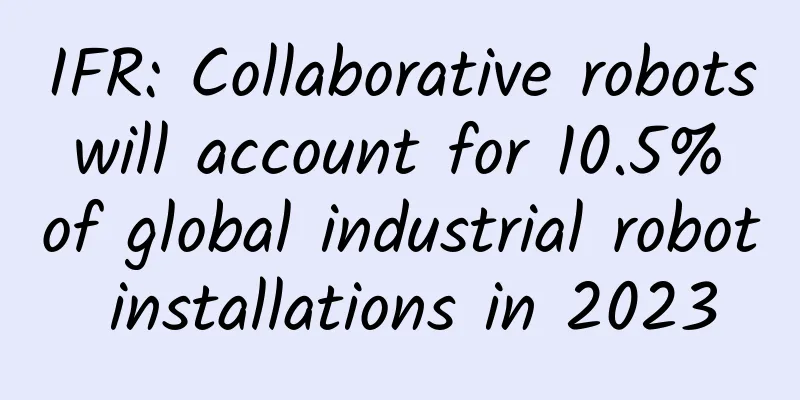IFR: Collaborative robots will account for 10.5% of global industrial robot installations in 2023

|
The world continues to face a growing labor shortage and robotics technology has emerged to address this challenge. In 2023, collaborative robots will account for 10.5% of the global industrial robot installation market. Collaborative robots offer a quick entry point into automation. They are easy to program; some are programmed by manual guidance (known as “guided teaching”) or through a tablet interface. Collaborative robots often do not require additional safety measures to be implemented on the factory floor. This allows fence-free operations to be integrated directly into existing production areas. For example, they can be used flexibly with plug-and-play technology. This is particularly attractive for companies without engineering expertise, with smaller production batches, and in industries with changing production needs. Collaborative robots and traditional industrial robots Collaborative robots often come with some trade-offs compared to traditional industrial robots. This is due to the fact that they are designed and intended to work safely alongside humans: collaborative robots are not currently suitable for processes that require high payloads and high speeds. Their lightweight design supports easy relocation and simplified integration into mobile robotic platforms. Collaborative robots are used in many environments where direct human-robot interaction is not required. In these cases, traditional industrial robots can be an option. But collaborative robots have additional safety features and capabilities that are useful for many applications. In situations where human intervention is required, industrial robots equipped with external safety measures can provide a good solution without compromising speed and payload. Safety measures include laser scanners, locking safety gates or safety mats. The manufacturing industry was an early adopter of collaborative robotics technology, including automotive, electronics, aerospace, consumer goods, pharmaceuticals, logistics and warehousing. Due to the ease of use of collaborative robots, we typically see industries that require low-volume, high-mix production. This can include welding, machine tending, case picking and end-of-line palletizing. Trends Driving Collaborative Robotics The shortage of skilled workers will drive the development of automated solutions and will re-establish the manufacturing infrastructure closer to consumers. New applications are being developed for collaborative robots, continuously expanding their potential areas of use - from simple handling, to welding, to painting, dispensing and assembly. Collaborative robot manufacturers are developing machine learning systems so that collaborative robots can "learn." This modular technology and learning method can further expand what collaborative robots can do when they are unattended. In the future, new sensors, vision technologies, and artificial intelligence (AI) will enable robots to respond to changes in their environment in real time, allowing them to work safely and sensitively alongside human workers. Cobot Market Collaborative robots account for 10.5% of the 541,302 industrial robots installed in 2023. The IFR statistics show that collaborative robots will supplement - rather than replace - investments in traditional industrial robots, which operate at much faster speeds, so collaborative robots will still be important for improving productivity in response to tight product margins. |
<<: Why aren’t second-hand iPhones popular?
>>: Experience of using Xiaotiancai phone watch: Who wants it more, the baby or the parents?
Recommend
The location of Wenchang Tower before the exam
Many parents are very concerned about their child...
What are the functions of Foshan WeChat Convenience Store Mini Program? How to create a convenience store mini program?
As people's pace of life continues to accelera...
0.4% of travel accounts for 55% of carbon emissions? | Expo Daily
0.4% of travel accounts for 55% of carbon emissio...
Massive advertising strategy in the cosmetics industry!
A large customer base is a prerequisite for the r...
Over one million new users in half a year, activation cost less than 2 yuan, how did I achieve it through QQ space large account promotion
Friends who do promotion should all have this fee...
If you point a flashlight at the sky, how long will it take for the light to fly out of the solar system?
This article is based on answering questions from...
How to keep smart home products fresh?
The replacement of electronic products has reached...
Unable to avoid information manipulation, is the human brain outdated?
Why are humans so susceptible to believing obviou...
Data Operations: How can operations train their data thinking?
What does “data sensitive” mean? You may have bee...
How to make a mobile phone that will satisfy Ren Zhiqiang?
The Qihoo mobile phone brand launch on the aftern...
How to delete completed orders in WeChat Mini Program?
Q: How to delete completed orders in WeChat Mini ...
Do product managers need to learn technology? Here is the best answer
I have always believed that learning new knowledg...
Information flow advertising placement case in the wedding industry!
I believe everyone is familiar with information f...
How can short videos use Baidu to accurately attract traffic?
I haven’t written an article for a long time. Tod...
Is it difficult to convert users into promotion? Catering to the fun point is the key
With the development of information flow advertis...









